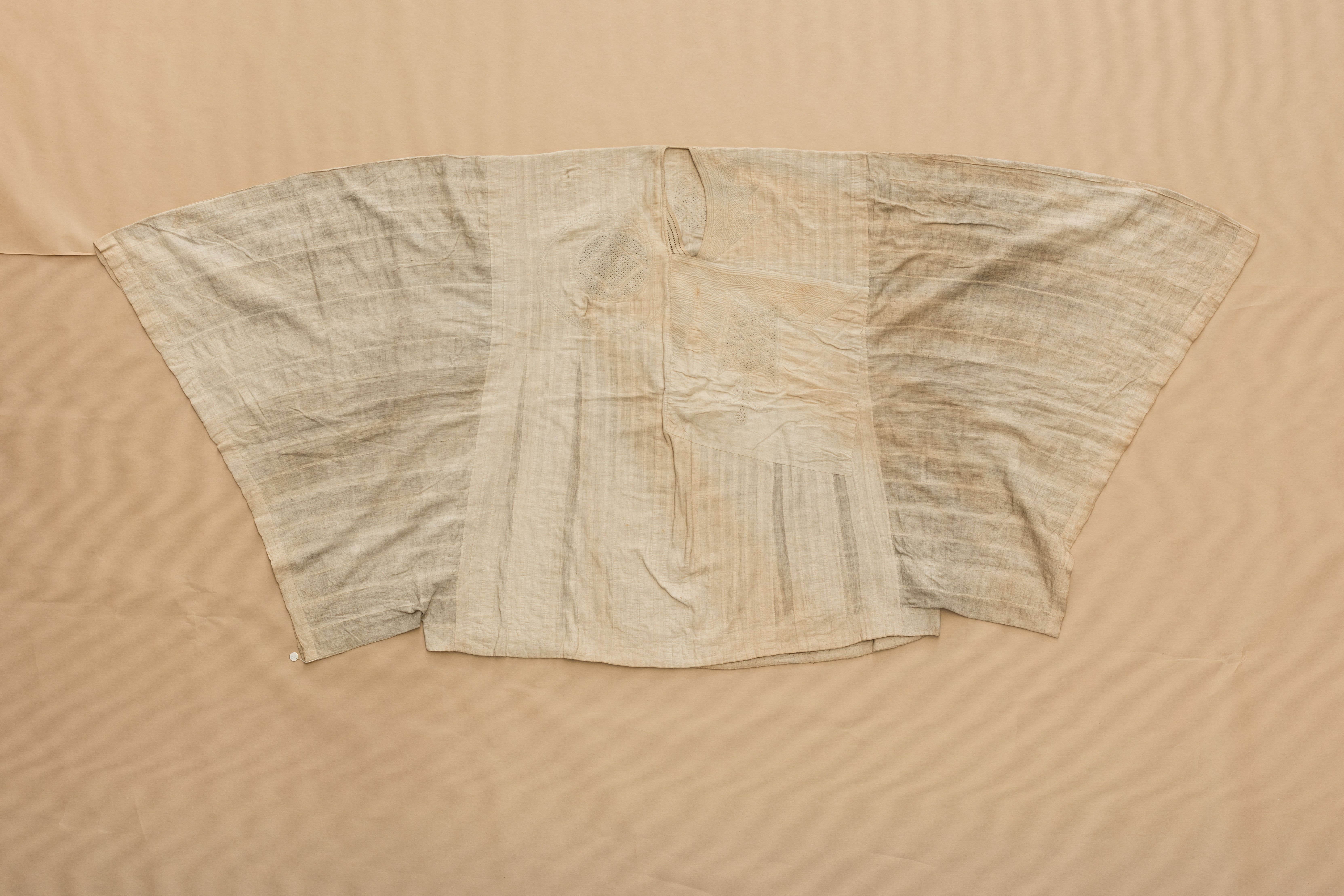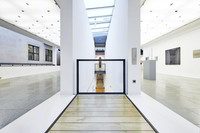A white embroidered robe of the Hausa from cotton, which consists out of narrow woven stripes that are sewed together (stripweave). The central section is from vertical stripes and the sleeves from horizontal stripes. At the neckline, a braid and embroidered ornaments are applied. Below the neckline, a sewed on, rectangular pocket begins that spreads out on the left side of the robe. The pocket is as well embroidered with different ornaments (i. a. with the so-called "two knives" / "asaka biyu" motive). In the front, on the right side of the robe, is a circle ornament that is surrounded by a spiral line. The inward of the circle is crossed with a square and filled with the round broderie anglaise (eyelet embroidery). On the back the circle ornament repeats (so-called "tambari" motive).
In the region of the Hausa states existed a richly textile production and the manufacture of large, splendid garments already before the 16th century. With the expansion of the Islam and especially with the establishment of the Islamic Sokoto Caliphate (1804 - 1903) a tremendous growth of the textile production came about. Such wide, embroidered robes expanded in West Africa in the 19th century related to their meaning in the Sokoto Caliphate. The manufacture of the garments there was connected with the Islamic administration. They became the official dress of the Caliphate by denoting the representatives of the administration and by being worn by the Muslim elite regardless of the ethnicity. Moreover, they were indicators for the rank and prestige and had diplomatic functions - i. a. as gifts. In Sokoto the robes were as well produced for the export market across West Africa. In the 19th century, men wore such robes. In general, they are termed "babban riga" in the Hausa language. In the Sokoto Caliphate they were also called "rigan giwa" ("robe of the elephant") in their function as status symbol.
The object is part of the bundle that came in March 1910 as a gift from Oberleutnant (first lieutenant) Picht into the collection of the Gewerbemuseum (Museum of Applied Arts) Ulm. The donor was Erhard Picht (1882 - 1910) who acted from 1900 on for the field artillery regiment "König Karl (1. Württembergisches), Nr. 13" in Ulm/Ludwigsburg and worked starting in 1904 as director in the Westafrikanische Pflanzungs-Gesellschaft "Victoria" (West African plantation corporation) in Cameroon. 1908 Erhard Picht had a collection of African items transported to Berlin where he lived sporadically. Among them were probably also objects that came to Ulm in 1910. A part of this collection he sold already in 1908 to the ethnological museum in Berlin. In April 1910, Erhard Picht died from malaria in Berlin shortly after his donation to the Gewerbemuseum Ulm.
It is possible that Erhard Pichts's brother Heinrich was involved in the processing of the donation or that he was even concerned in the collection of the African objects. Heinrich Picht (* 1884) worked as a planter in Cameroon since 1902 and founded in 1907 the Deutsche Kautschuk-AG (German Rubber Corporation, from 1923 on named Ekona AG) with main office in Berlin. Around 1903 he obtained the order to gain local workers for the plantations by bargaining with the native tribe patriarchs. For this purpose, he set out on a journey through the North Western Cameroon resp. the present province Northwest Region. Some of the objects from the donation come from the region where Heinrich Picht was on his way.
en

